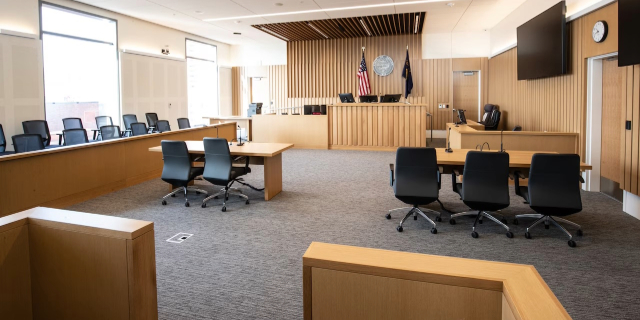Oregon lawmakers, others optimistic latest plan will help solve public defender crisis
Published 10:31 am Sunday, June 29, 2025

- The backlog of defendants without public defenders has more than doubled in Washington County and nearly tripled in Multnomah County in the past year. Multnomah County photo
Prescribed course of action should ‘put the state on a trajectory toward’ fixing the problem within a year
Oregon lawmakers approved a budget package this week that they and others are optimistic may solve the state’s years-old public defender crisis, which has stalled prosecution of at least 3,600 criminal defendants currently waiting for a lawyer.
The money will fund a plan that the interim director of the Oregon Public Defense Commission, Ken Sanchagrin, submitted to Gov. Tina Kotek in early June. Key components include allowing experienced public defenders to push their caseloads above state-imposed limits — and earn more pay for their extra work. On the flip side, the plan calls for slashing the pay of or even firing public defenders whom the state believes aren’t representing enough defendants.
Lawmakers and prosecutors in Oregon’s two most populous counties — Multnomah and Washington — say they’re hopeful the plan will make significant progress toward ending the crisis. Since 2022, the lack of taxpayer-paid lawyers for defendants who otherwise can’t afford counsel has stymied the prosecution of thousands of accused criminals charged with a wide range of offenses, especially lower level ones like stealing cars, drunken driving, shoplifting and ID theft.
The head of Oregon’s largest nonprofit public defense firm said he too feels “tempered optimism” about the legislative package.
“But,” said Sen. Anthony Broadman, a Bend Democrat and chief backer of the legislation, “we aren’t standing in front of a ‘mission accomplished’ sign. There’s a lot more work to be done.”
House Bill 5031, which passed the House last week and the Senate this week, allocates $707 million to the Oregon Public Defense Commission to manage and compensate public defenders for the next two years. That’s a $91 million boost from the current biennium — a 15% increase, with a chunk of it designated to fund Sanchagrin’s plan.
Sanchagrin says he believes his prescribed course of action should “put the state on a trajectory toward” solving the crisis within a year.
A second measure, House Bill 2614, which would allow the governor to fire the commission’s executive director for “just cause,” among other provisions, cruised to passage in both chambers Thursday and awaits the governor’s signature.
Key components of both bills and Sanchagrin’s one-year plan would:
— Designate $2.2 million to pay for the most experienced public defenders to take on more clients in the highest need counties, if it doesn’t compromise the quality of work they do for existing clients. For example, a veteran public defender who is currently only allowed to take on 138 major felony cases per year would be allowed to handle 15% more, or about 20 additional cases per a year.
— Improve the efficiency of public defenders with low caseloads. A public defender who is working below 85% of capacity — handling 117 or fewer major felony cases per year — could be put on an improvement plan to increase their caseload, get a pay cut or lose their job.
— Ease first-year public defenders into the job by allowing them to work 200 cases instead of the maximum caseload of 300.
— Funnel $3.4 million to Oregon’s three law schools, at Willamette University, Lewis & Clark and the University of Oregon, to train and supervise 120 law school students so they can represent misdemeanor defendants.
— Allow privately practicing lawyers who band together to divvy up a share of public defense cases to continue to do so, instead of phasing them out of public defense work. These groups are known as consortiums and are largely credited with averting a public defender shortage in many Oregon counties, including Clackamas County.
— Designate about $500,000 to pay a full-time state employee to help counties expand fast-track programs that allow public defenders to quickly reach plea deals with prosecutors, sometimes in a matter of days.
— Release tens of millions in funding to the Oregon Public Defense Commission only after it reports back to state lawmakers in 2026 on progress or pitfalls encountered in implementing the one-year plan.
This isn’t the first time lawmakers have tried to stem the problem of criminal defendants who languish in limbo for weeks or months as they wait for constitutionally guaranteed lawyers when they can’t afford one. In the 2023 session, lawmakers approved more than $90 million to secure more defense lawyers and slightly increase their pay. House leaders announced that they’d “fulfilled their commitment to addressing the state’s public defender shortage,” but in ensuing months, the number of unrepresented defendants only grew.
Another plan, approved by the Oregon Public Defense Commission in 2024, was deemed a flop by an Oregon Judicial Department analysis in early 2025. For one, that review determined a 20-person strike team of highly-paid state-hired public defenders had barely made a dent in the problem.
In a letter to the Legislature this spring, Commission Chair Jennifer Nash said the commission has had five executive directors since 2021 and three different sets of commissioners, with the chief justice of the Oregon Supreme Court or the Legislature replacing members twice.
Since the problem of unrepresented defendants emerged in Multnomah County in early 2022, it’s grown to encompass at least two thirds of the state’s counties. Six with the most intractable challenges have been categorized as “crisis counties”: Coos, Douglas, Jackson, Marion, Multnomah and Washington.
Carl Macpherson, executive director of Metropolitan Public Defender, the state’s largest public defense firm, said he is reserving judgment on Sanchagrin’s one-year plan until it fully rolls out. But he said he’s hopeful it will bring improvements.
That’s even though the plan only calls for inflationary pay raises. It also doesn’t include money to hire more public defenders to lower caseloads system-wide.
In a news release Thursday, public defense firms across Oregon said pay raises and lower caseloads are desperately needed to keep public defenders from leaving for higher paying, less stressful work.
“The reality is that Oregon simply needs more public defenders,” Caitlin Plummer, executive director of Public Defender Services of Lane County, said in the news release.
Multnomah County District Attorney Nathan Vasquez and Washington County District Attorney Kevin Barton, however, say they believe the crisis can be solved without hiring more public defenders. What does need to happen, they contend: Current public defenders need to increase their caseloads.
A top state judicial official told lawmakers earlier this year that in 2019 there was one public defender for every 177 cases and this year the number has plummeted to one lawyer for every 93. Some public defense leaders dispute those numbers, arguing that the analysis was flawed.
Meanwhile, the crisis is most intense in Multnomah and Washington counties, where the number of defendants without constitutionally-guaranteed lawyers has doubled to tripled in the past year. Oregon Public Defense Commission data shows that at the same time, the rest of the state as a whole has been improving.
“In a sea of data,” Barton said, “those two things really jumped out at me as ‘Oh my God moments.’”
Barton said that’s why a solution is needed now more than ever.
“The crisis,” he said, “has become markedly worse.”






